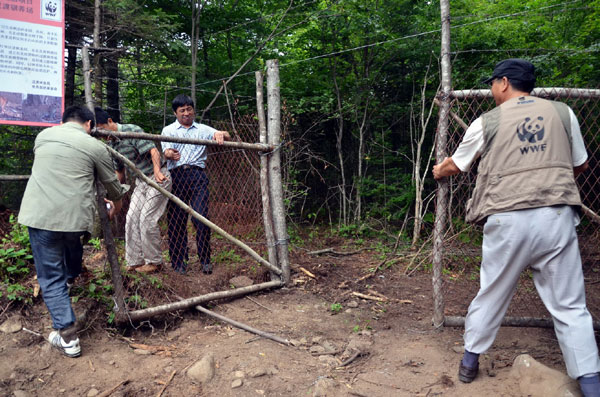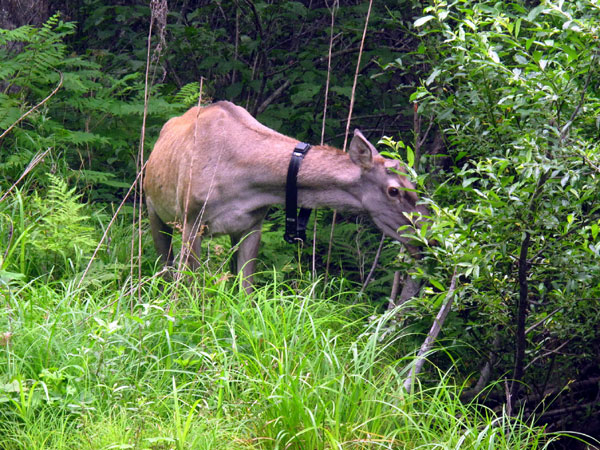Over 30 deer released to appease tigers
Updated: 2012-07-30 07:39
By Wu Yong and Han Junhong (China Daily)
|
||||||||
More than 30 captive red and sika deer were released into the wild on Sunday in Northeast China's Wangqing Nature Reserve, in a bid to reestablish the food chain for wild Siberian tigers.
The release is part of a tiger recovery trial project run by the World Wild Fund for Nature and the Forestry Department of Jilin Province. It aims to repopulate the area where China's few remaining tigers live with desirable prey, a crucial first step in improving living conditions of the endangered big cat.
Over the past 50 years the Siberian tiger population in China dropped from an estimated 200, to just 15 last year, due to massive pressure from deforestation, economic development and poaching. However, more than 500 wild tigers live across the border in Russia, according to WWF.
 |
|
Personnel from the World Wild Fund for Nature and the Forestry Department of Jilin Province open a fence to release deer into the wild at Wangqing Nature Reserve in Jilin on Sunday. Zhang Ke / for China Daily |
A recent WWF-backed survey found that lack of prey was a major hurdle in supporting the settlement of tigers in Northeast China. The same survey found that the number of ungulate animals in the Changbai Mountain area, especially favored prey such as red deer and sika deer, is too low to support the recovery of the Siberian tiger population.
"There is very little prey for the 15 wild Siberian tigers now living in Changbai Mountain, which limits the growth of tiger numbers in China. We believe that releasing deer will help recovery efforts. Increasing the breeding population of the prey will restore the food supply chain and help attract the settlement of Siberia tigers in the long run," said Fan Zhiyong, director of WWF China's species program.
Fan said WWF will not stop working on this project until wild tigers have an adequate food supply.
WWF's survey found the density of red deer and wild boar is only 0.3 per square kilometer on Changbai Mountain, less than half the number in neighboring Russia's Far East region that has a far healthier tiger population.
 |
|
A red deer was returned to the wild at Wangqing Nature Reserve on Sunday as part of a tiger recovery project. Zeng Ming / for China Daily |
Jiang Guangshun, a senior researcher from Northeast Forestry University, who has engaged in wild tiger research for decades, had high praise for the project.
"It is a great chance for China to attract wild tigers back home because we have not seen them since the 1970s. And we want them to settle down in China, not roam around the border," said Jiang.
He is also backed by Zhu Jiang, head of WWF China's Northeast Office. Zhu told China Daily that this initial trial would help create the conditions needed to support the survival of at least one female tiger in the Wangqing area. The presence of a tigress can help in getting tigers to settle in an area.
Siberian tigers mainly live in East Russia, Northeast China and mountainous areas in the Democratic People's Republic of Korea.
Contact the writers at wuyong@chinadaily.com.cn and hanjunhong@chinadaily.com.cn

 Relief reaches isolated village
Relief reaches isolated village
 Rainfall poses new threats to quake-hit region
Rainfall poses new threats to quake-hit region
 Funerals begin for Boston bombing victims
Funerals begin for Boston bombing victims
 Quake takeaway from China's Air Force
Quake takeaway from China's Air Force
 Obama celebrates young inventors at science fair
Obama celebrates young inventors at science fair
 Earth Day marked around the world
Earth Day marked around the world
 Volunteer team helping students find sense of normalcy
Volunteer team helping students find sense of normalcy
 Ethnic groups quick to join rescue efforts
Ethnic groups quick to join rescue efforts
Most Viewed
Editor's Picks

|

|

|

|

|

|
Today's Top News
Health new priority for quake zone
Xi meets US top military officer
Japan's boats driven out of Diaoyu
China mulls online shopping legislation
Bird flu death toll rises to 22
Putin appoints new ambassador to China
Japanese ships blocked from Diaoyu Islands
Inspired by Guan, more Chinese pick up golf
US Weekly

|

|






